Ice-drifting the last Ferrari V8-powered Maseratis is one way to say goodbye
Next year marks a big step in the tale of Maserati, as the last batch of V8 engines in the Italian marque’s long history will finally roll off the assembly lines at Modena and Turino. That story runs the gamut from early open-wheeled racecars in the 1930s to modern twin-turbocharged V8 mills built by Ferrari and then dropped into uber-opulent tourers, including the full-size Levante SUV. To celebrate such V8 heritage, Mas decided to run out a pair of final-edition packages for the 2024 Maserati Levante and Maserati Ghibli, dubbed the “Ultima” and “334 Ultima,” respectively.
But as something of a (much more) surprising send-off, Maserati then invited media to Northern Italy, in the middle of winter, up to a ski resort, at over 6,900 feet of elevation, to take these final V8 cars ice drifting on a snowy racetrack. Unusual and unexpected, to say the least, but an opportunity I obviously could never pass up. And that’s how I wound up spending 17 hours flying to Milan, then another three hours driving further into the picturesque Alps, surrounded by stunning cliff faces shrouded in low clouds and dotted with terraced vineyards or marble quarries, up past Lake Como, through the low valleys, and into the small ski town of Bormio near the Swiss border.
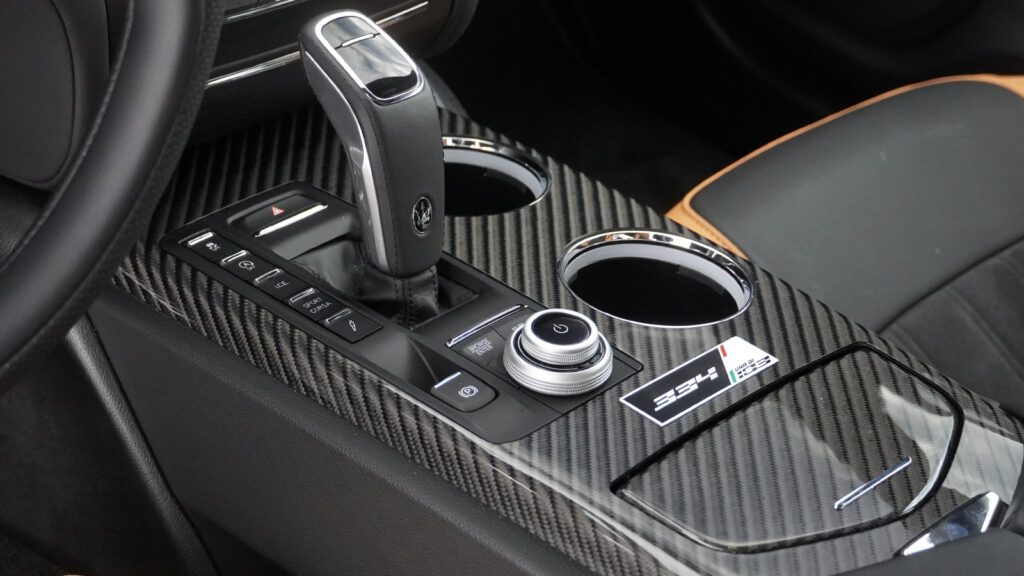
When past and present meet in Maserati showrooms
This trip actually presented my first opportunity to drive the outgoing Maserati lineup since most of the company’s many press events over the last couple of years since pandemic travel restrictions lifted fittingly focused on the three forthcoming models that aim to transition Maserati towards larger scale production and a wider customer base. The process started in eye-popping form with the eye-catching MC20 supercar, a stone-cold stunner equipped with a raucous Nettuno twin-turbo V6 engine featuring pre-chamber combustion tech borrowed from F1 racecars.
The turbo whooshes and hardtop convertible of the Cielo trim make the MC20 my second favorite supercar on the market today—sorry, nothing beats the Lamborghini Huracán Sterrato for outright absurd fun—but enforced scarcity means that infinitely more potential consumers will undoubtedly envision the new Maserati Grecale crossover as a possible entry point to Maserati as a brand. Aimed squarely at Porsche’s Macan and Cayenne, the Grecale also gets a Nettuno engine option, though with a dialed-back ECU tune, as well as a mild hybrid system and an eventual all-electric version.
Last but not least, Maserati also re-booted the GranTurismo this year with a more contemporary exterior that borrows cues from the MC20 and—you guessed it—a pair of detuned Nettuno engine options plus an upcoming all-electric Folgore trim. The GT’s full packaging leans more toward sporty than the traditionally soft grand touring cars that inspired its name, but with all-wheel drive and a low-slung chassis, it manages to nail that middle ground nicely nonetheless.



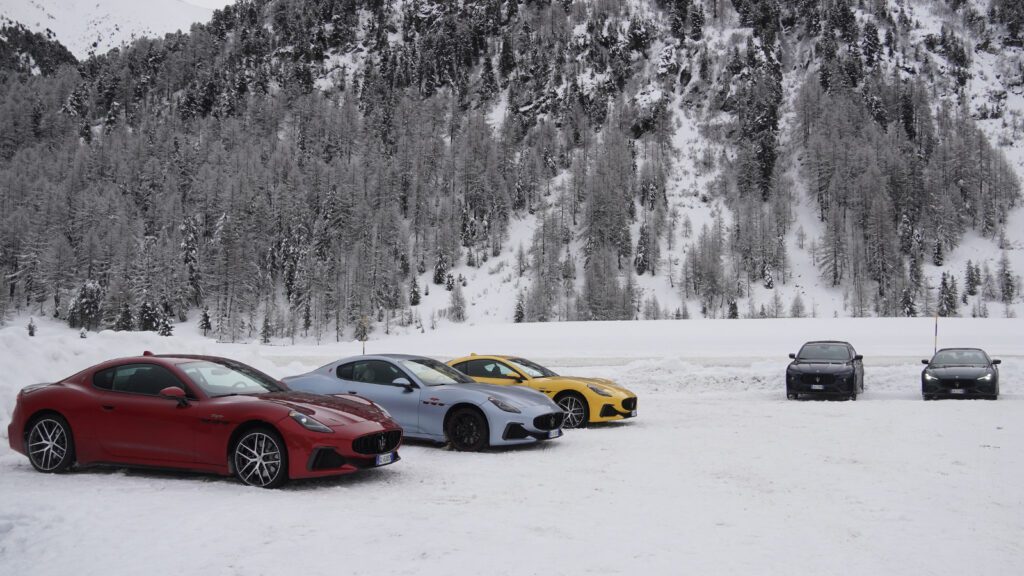
The three new models will overlap with the outgoing Levante, Ghibli, and Quattroporte for 2024, so I arrived in Bormio very curious to experience how the older cars perform. Imagine a customer walking into the showroom and getting to test drive all six side-by-side. Does the new-new, packed with tech and a lighter turbo V6 engine, take the cake? Or maybe the staid, refined spirit of Maserati’s more historical feel paired with the 3.8-liter Ferrari V8? At this turning point throughout the automotive industry, somehow, past and present paired up side by side most perfectly at Maserati.
For the drive up to Livigno, another ski town with an ice track nestled even nearer to the Swiss border, Maserati tossed me into the Ghibli 334 Ultima, which adds lighter wheels and a carbon fiber aero package to that 572-horsepower Ferrari V8 to produce the fastest sedan in history. The 334 refers to a top speed of 334 kilometers per hour—or 207.5 miles per hour—made possible by additional downforce, less drag, and new tires developed specifically for this application.
I never hit anywhere near that top speed, thanks largely to wet and cold roads that dictated care while navigating hairpins, in addition to true Pirelli winter tires on 21-inch wheels rather than the as-yet-secret special tires. Over tall passes, roaring through tunnels with openings exposed to the elements, the climbs and descents reminded me of scenes straight out of the Tour de France and Giro d’Italia. Unfortunately, the Stelvio Pass nearby—scene of so many epic cycling battles, not to mention James Bond tomfoolery—was already closed due to the winter snow.
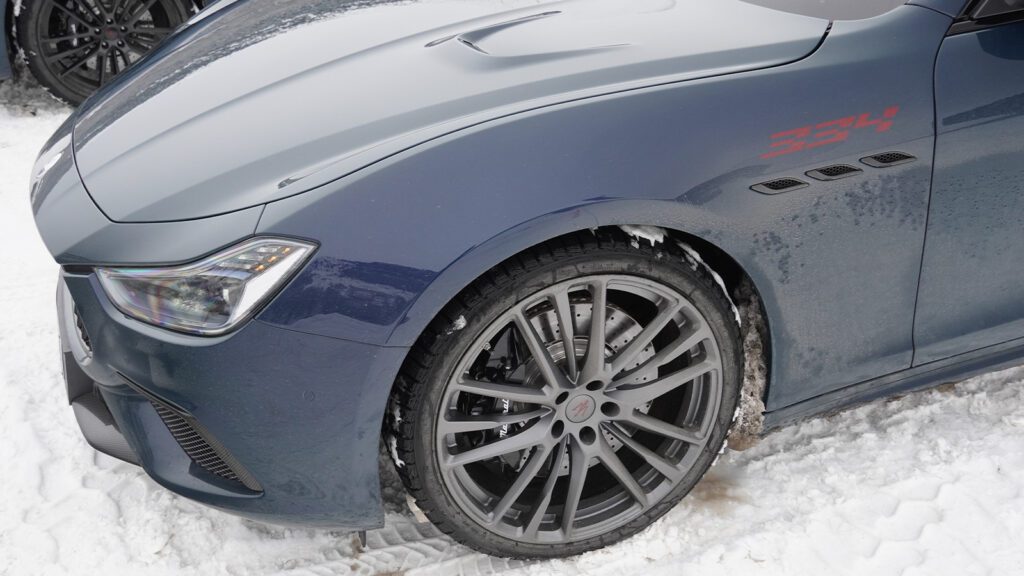
But on those wet roads, with ice and snow packed up around six inches in turnouts, so many tight hairpins never stressed the 334. Low-end torque from the V8 never caused a moment of slip-and-slide, despite wheeling a long four-door with a curb weight of nearly 4,300 pounds around the bends. Of course, I kept traction control and electronic stability control fully activated, but I also never noticed any intrusions from the electronic nannies. Unbeknownst to me at the time, TC and ESC would wind up becoming a big focus of the rest of the day.
Three old Maseratis walk into a ski bar
I pulled the 334 into a snowy parking lot just off the main road through Livigno as cross-country skiers huffed and puffed along a track to the left and alpine riders ripped around the tree line, maybe 600 vertical feet above us. Maserati’s safety team gave us a quick briefing on what to expect for the day, and then we hopped into a Ghibli for a couple of sighting laps with a test driver. He played a bit between drifting and taking time to demonstrate all the settings for drive modes, TC, ESC, and paddle shifting—then, again, to the amazement of all, simply pointed to our cars and sent us out onto the ice. No helmets, nobody in the passenger seat to rein in any potential shenanigans, just lap after lap of ice-drifting fun.
Earlier this year, I spent a day on the ice with the Polestar 2 Arctic Circle edition at Circuit Mecaglisse in Canada but immediately recognized the folly of comparing a fully electric Swedish concept car to a bunch of opulent V8-powered Italian grand tourers. So I spent my first two laps with ESC fully on, aware of my own penchant for spinning cars and getting stuck in snow. I felt out the winter tires—Maserati installed winter Pirellis on the Ghibli and Quattroporte but Continentals on the Levante—with all the electronics holding me back, could easily floor the throttle without coming anywhere near losing grip. And this is in a heavy, powerful, rear-wheel-drive sedan, remember?
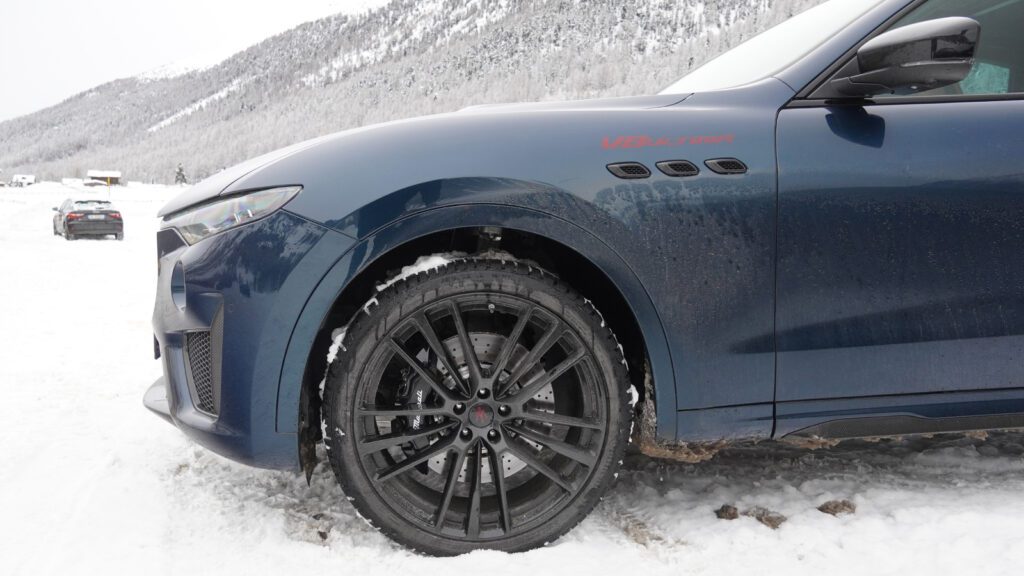
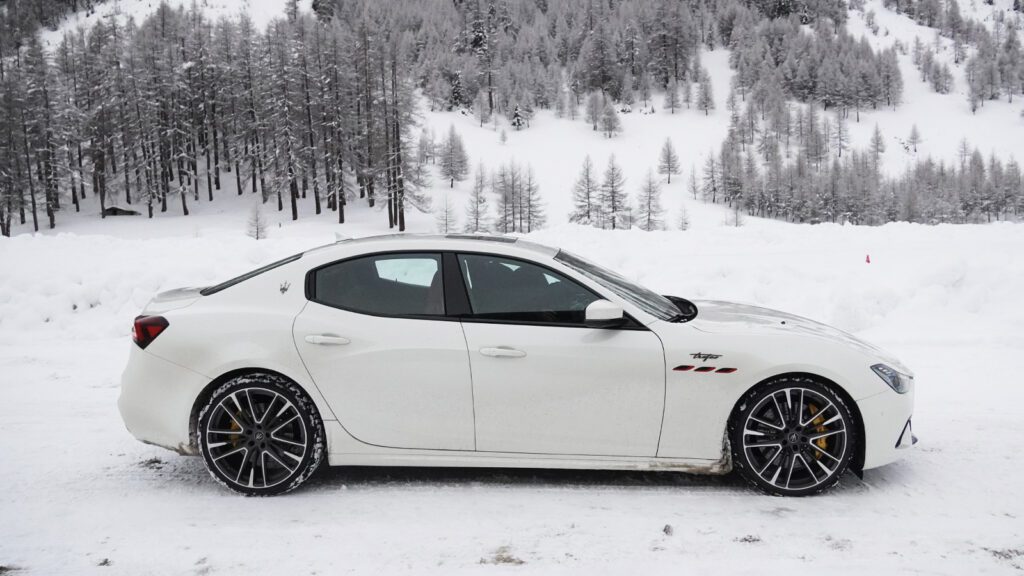


I turned ESC fully off. In the first lap, my own inhibitions allowed me to only ease into a couple of slides. But confidence builds quickly, perhaps too quickly—this is a heavy, powerful, rear-wheel-drive sedan, remember. I kept the transmission in auto mode and the drive mode in Normal, thinking the softest suspension would best keep me from upsetting the car’s balance.
But even in Normal, I felt the surging boost of that Ferrari V8 building, pulsing through the rear tires, and by the tightest turn of my second ESC-free lap at the far end of the track, I spun out pretty good. Happily, my ego suspects nobody noticed because I recovered quickly and kept working through the rest of the course, slaloming between understeer and then stabbing into oversteer with a quick hit of the throttle, big V8 easily setting the rear tires loose until the turbos spooled up to keep them spinning for a second or two even after I lifted.
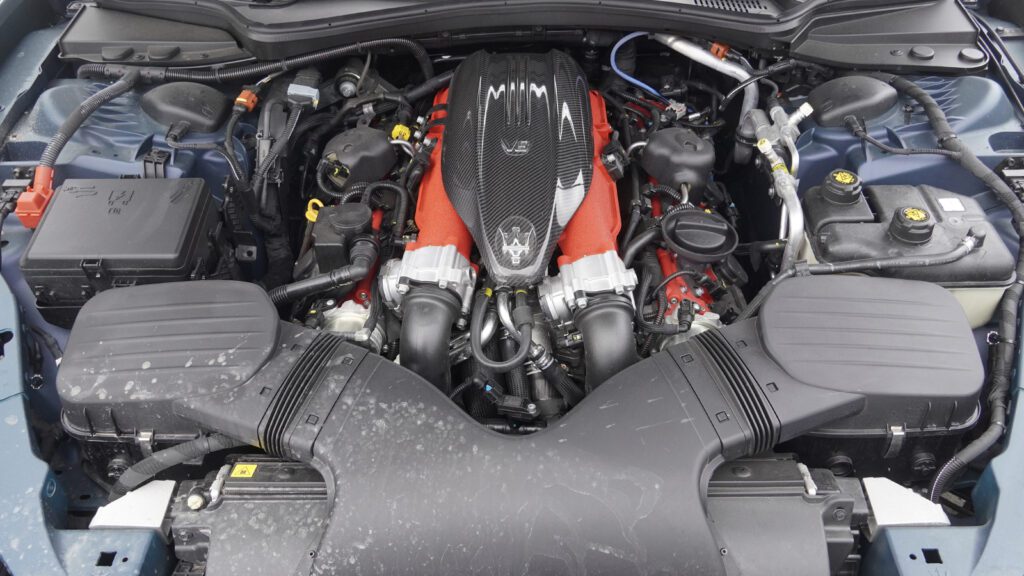
After a few laps, I settled into a zone of progressively wider slides, trusting the front wheels to retain a bit of grip in mild countersteer while the tail end pushed us into and then out of the drifts. On level ground or coming up over a rise, especially, the Ghibli managed easy rally-style transitions between short S-curves, then happily bent akimbo through a final wide rip into the pits.
I handed off driving duties to a fellow journalist and, grinning ear to ear, walked over to chat with Maserati Senior Global Product Planner Victor Eumenidi. A huge Alfa Romeo nerd, Eumenidi admitted at dinner the night before that he’s hunting to find his dream car, a high-mileage SZ, probably out of Japan. On the ice track, he immediately asked with a sly smile whether I preferred the twin-turbo Ferrari V8 or an electric Polestar. I shook my head with a grin and asked why we were even here, playing in the snow, way farther out in left field compared to an all-wheel-drive Swedish commuter car.
“It’s fun,” he laughs. “And for us, it seemed like a great way to have fun with these cars. To celebrate the V8 engine and also to prove that, even if they are rear-wheel-drive cars, not only the Ghibli but also the Quattroporte, there is a lot of fun driving this car in the winter, in the snow, on the ice.”
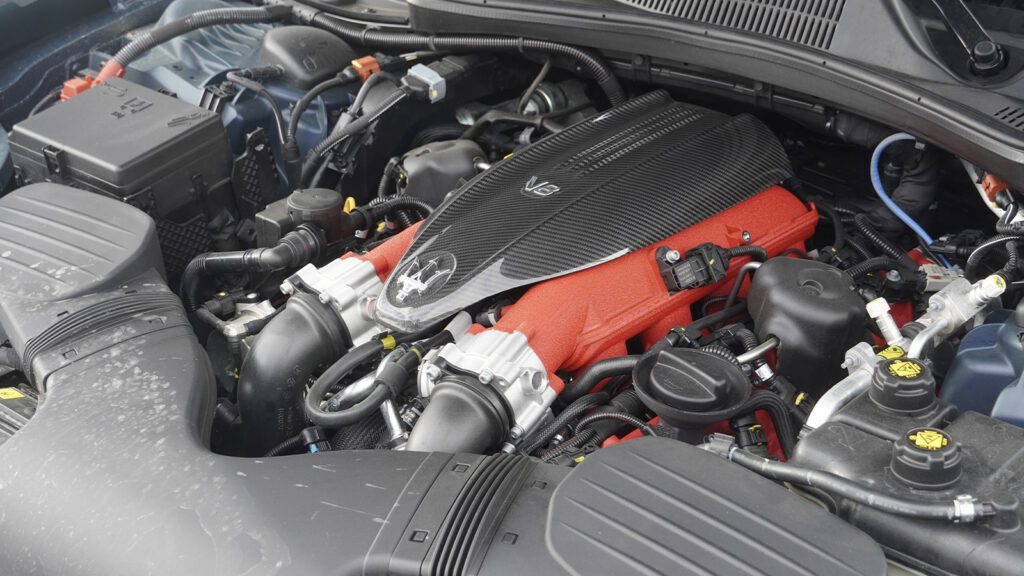
Swapping through the Maserati lineup
With media on hand alternating between driving the Levante Ultima and Ghibli 334 Ultima on asphalt, I then received a new GranTurismo in top-spec Trofeo trim to take out on the track. And here, the decision-making seemed clear since the Trofeo pairs all-wheel drive with that Nettuno V6 now putting out 542 horsepower in a low-slung chassis. Surely, the better car for this day, right?
And yet, even after forcing myself to take another test lap with ESC on, I found the GT much harder to set into a happy flow. In this case, maybe more grip required too much more speed—not necessarily ideal for tight, technical twists on increasingly chopped-up ice—but the Nettuno engine also requires more revs to spool up into torque and set the tires spinning.
By the time I gained the confidence to hit the sheer velocity that could break through the chassis’ inherent grip, the transition from understeer to oversteer hit much more quickly, leaving me little room for error.


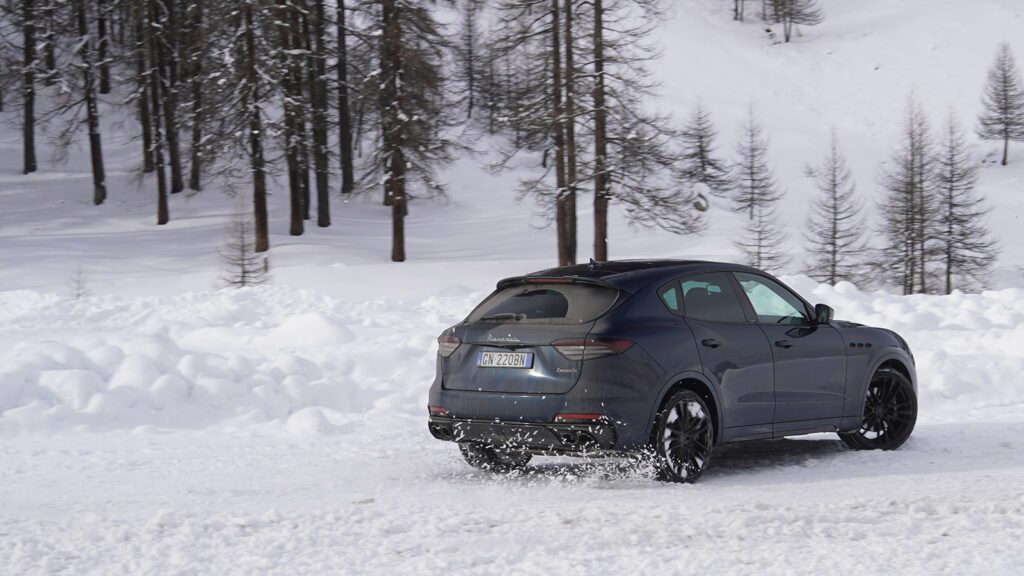
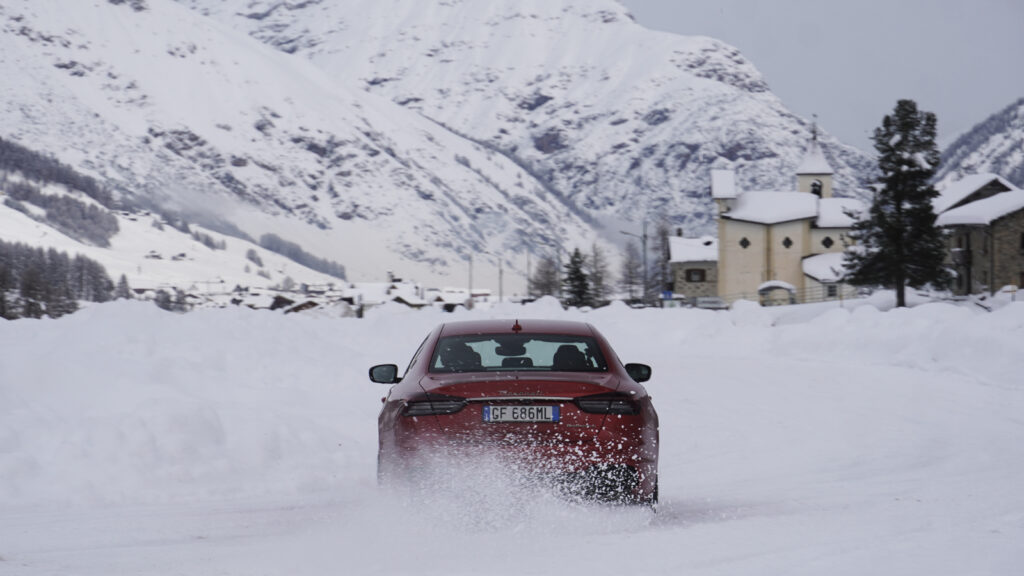
To be fair, I never spun the GT, even through the tightest corner that caught one Ghibli driver who needed six guys to push out from deep snow in the runoff zone. But my pace got faster and faster as a bit more tail slide entered the chat, so I also ended up waiting behind other drivers enjoying much more opposite lock in the RWD cars. Turns out, lap times aren’t necessarily best for racking up smiles per hour.
I pulled back into the pits with the GT and subbed into a Maserati Quattroporte executive sedan. Longer and about one hundred pounds heavier than the Ghibli, so still quite similar, the Quattroporte seemed to be the favorite of another journalist friend from duPont Registry who’d already been absolutely crushing the widest, fast drifts of the group. (He’d just spent four hours on a wet skid pad at BMW Test Fest, turns out, honing those sidewayz skillz in an M2.)
Following his lead, I threw the Quattroporte into Sport mode, which noticeably opened up the engine response and firmed up the suspension to somewhere between the soft Ghibli and the firm, almost harsh GranTurismo. Immediately, I discovered a new level of flow in the bigger sedan as the weight and power combined to create a sense of composure that kept me right on the edge of losing control.
Very impressive, I told Eumenidi when I returned to the pits. And he agreed, especially in contrast to his favorite car for ice-driving, the GranTurismo.
“Honestly, I love the Quattroporte,” he admitted. “A big rear-wheel-drive sedan for sure, but to me, in terms of handling, I found the car very easy. And for sure, the new GranTurismo, it’s a different thing, it’s way more easy to use, practical, and with rear-wheel drive, drives much faster in the snow.”

Lastly, Maserati gave everyone a final romp out on the ice in the Levante Ultima—with the caution to please be extra, extra careful because it’s the only one built so far. I went last after keeping an eye on how everyone (especially duPont over there, still crushing it) handled the larger, taller SUV weighing over 5,000 pounds. Behind the wheel, I decided to risk Corsa mode to prioritize the all-wheel-drive system’s rear bias, but even still, the Levante’s additional suspension travel made for a much smoother ride than all the other cars.
The softer ride helped me work with nose and tail weight distribution, gobbling up the by-now-shredded track. Corsa also opened up the Ferrari engine’s exhaust valving and automatically set me into manual shift mode. With my ears more easily able to keep track of revs without glancing down at the tach and nearly redlining repeatedly, I sent the Levante through each turn almost perfectly, hammering throttle this time but only feathering steering input, trusting the fronts to gently pull us through with less countersteer until a hint of Scandinavian flick opened up the rears again into the next corner. After only a couple of laps, I sent it too hard into my final bend and spun a nice 180 like a full-on Hoonigan.
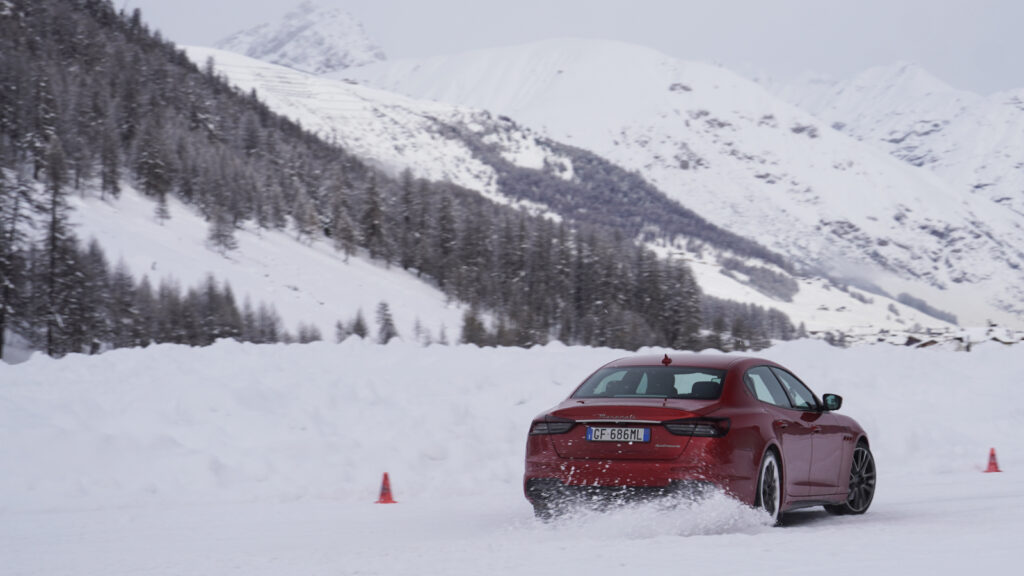
Box box box, apparently. Tempted to act like I couldn’t get back into the pits without another lap, I cranked the steering wheel and floored it, spinning the Ultima through another tight 180 like the best rally driver on the planet, then slow cruised into the pits. Nobody cheered, but rest assured, the crowd in my head kept the applause roaring for at least a few minutes.
I told Eumenidi that I enjoyed the Levante Ultima most and wondered whether inherent chassis similarities to the trucks, SUVs, and side-by-sides I take out for hardcore desert ripping produced a more familiar comfort zone. Of course, none of those have yet sported a 572-horsepower twin-turbo Ferrari V8—but a guy can dream, right?
Surprisingly nice, if undoubtedly dated, Maserati finales
I also took the Levante Ultima out for a quick rip on asphalt, where 99.9% of the potential total of 206 customers will spend their time. With far more grip, the low-end boost of that powerplant hooks up to render speed limits absolutely irrelevant—even on wet roads as the afternoon sun peeked through to melt more snow. Here, the traction control and ESC undoubtedly helped, though selecting Sport mode allowed for a bit more fun than Normal in the Levante 334 earlier in the day.


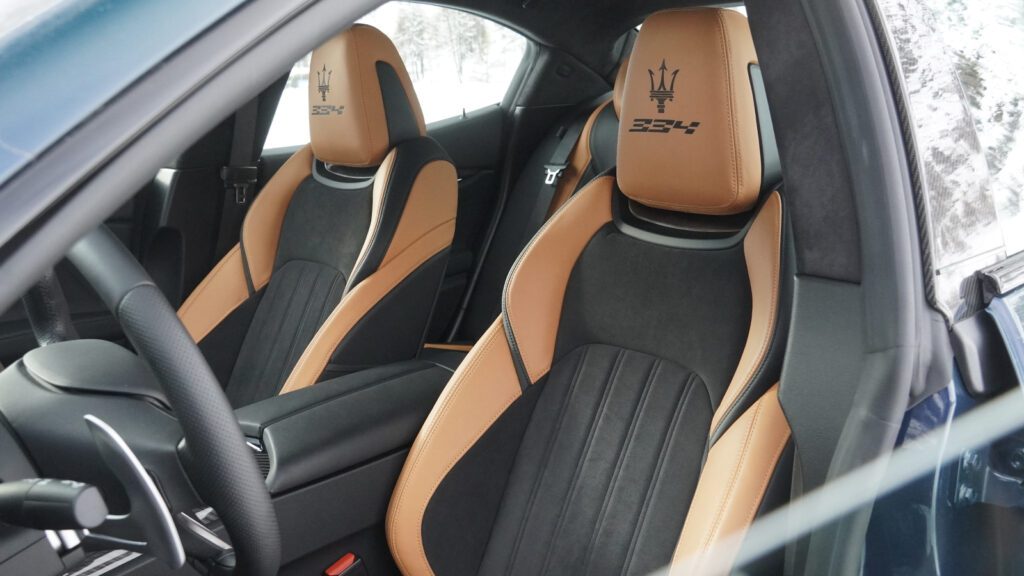

By the time we drove back to Bormio for a dinner of pasta and cured meats, I could confirm that these three outgoing Maseratis were surprisingly nice cars. Sure, the interior feels a little dated compared to the rest of the industry—not to mention the techy, minimalist designs of the MC20, Grecale, and GranTurismo—but the special two-tone leather treatment and all the carbon-fiber trim on the Ultima and 334 help to enhance the old-world luxury spirit. And wireless Apple CarPlay worked perfectly the whole time, even allowing me to pair it with the car moving each time I got in a new vehicle.
My mind still balks at the pricing for the Ultima and 334—which should be a serious step above even a “standard” Ghibli Trofeo for $125,195 or a Levante Trofeo at $168,495. But the limited production numbers and the final Ferrari V8 will likely serve as highlights to attract collectors, even if Eumenidi wanted to talk more about Maserati’s long history than Ferrari’s specific contribution.
Looking to tomorrow’s EVs while honoring yesteryear’s V8s
“Let’s not talk about the Ferrari V8,” he admonished me, “But the V8, in general, they were a big thing in Maserati history with more than a hundred thousand cars produced. And today we are celebrating these engines, so not only the latest Ferrari V8 but also the previous ones, all the V8 legacy of Maserati.”
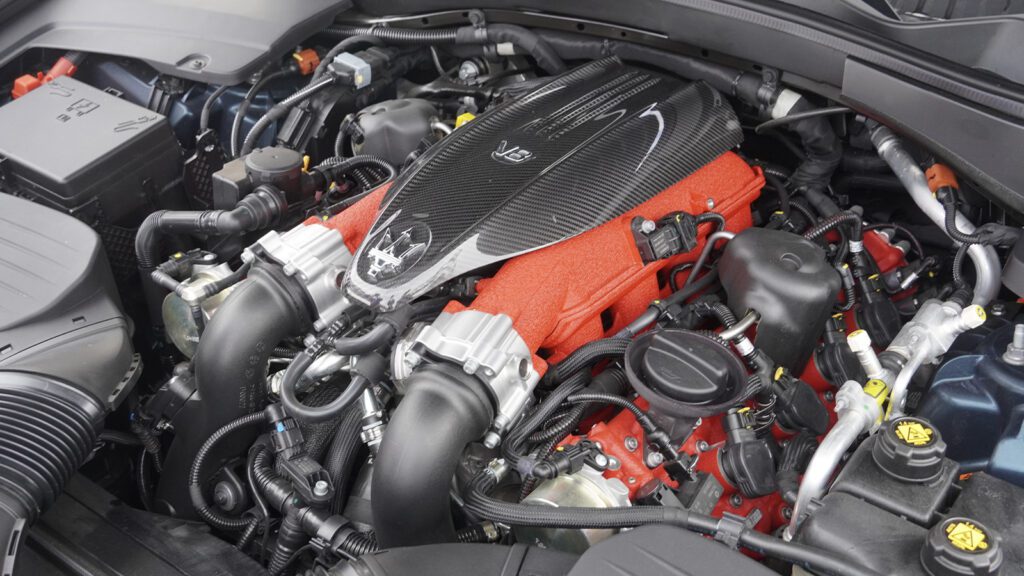
Longtime Maserati fans and newcomers to the brand alike might miss the V8 option after 2024, despite the obvious benefits of the Nettuno V6 and four-cylinder variants. But I left Italy wondering how the forthcoming Folgore electrics might have handled our day in the snow. Weight gains could be either a pro or a con, I suspect since I did find the heavier Quattroporte and Levante easiest to slide around the track. The optimal weight distribution of Maserati’s “dogbone” style EV powertrain installation will probably highlight the instantaneous torque of electric motors to make popping the rear tires loose as easy as I found on the Polestar—whether Maserati decides to program in a rear-biased drift mode, or something near to rear-only, will come into play big time since EVs can never turn ESC fully off.
That day at Mecaglisse in the Polestar 2 Arctic Circle provided plenty of thrills, without a doubt, and only a couple of spins despite studded tires. But, probably to the surprise of absolutely nobody, I enjoyed the days spent ice-drifting on an unexpected trip to the southern Alps in a handful of internal-combustion Maseratis so much more. Hopefully, the buyers who leap at this last chance to snap up a Ferrari V8-powered grand tourer will trust their tires and traction control settings enough to do so, as well.


